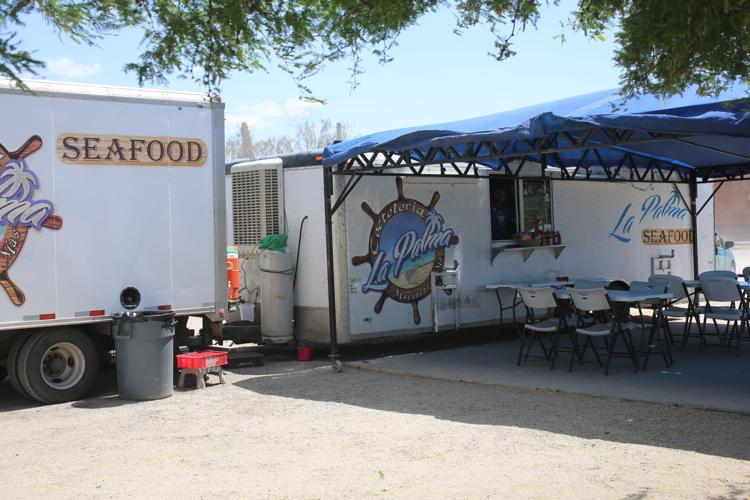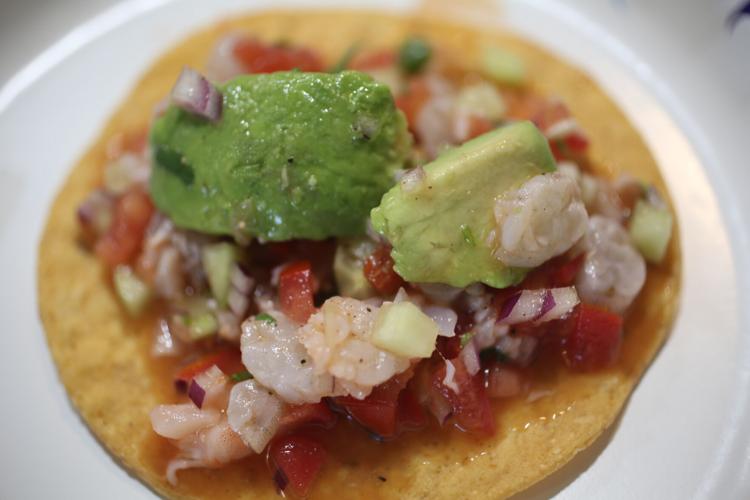Fried.
Covered in toasted coconut.
Tossed in a creamy Alfredo pasta.
Dunked into a bowl of cocktail sauce.
The ways to prepare shrimp are endless. Everyone has their own way to season the seafood delicacy; some may like it wrapped inside a corn tortilla with a spicy salsa on top and others prefer it thrown in a savory stir fry.
While those are all tasty meals, no one quite does seafood like Sinaloa.
Northwest of Mexico City and on the coastline of the Pacific Ocean sits Sinaloa, a Mexican state known for their seafood. Lime, cucumbers, spices and chiles are all used to transform fish and shrimp into a flavorful, fresh experience that instantly transports you to a sandy beach.
In a white food truck that sits diagonal from the Santa Cruz Catholic Church, Esther Romero and her family bring that flavorful experience to УлшжжБВЅ, adding another way to prepare shrimp to your favorites list.
Romero and her family own , a seafood truck located at that sells cocktails, tacos and tostadas with a Sinaloan flair. Originally from La Palma, Sinaloa, Romero and her husband, Mario, moved to УлшжжБВЅ in hopes of providing a better future for their kids.
Since they were both cooks, their dream was to start a food truck so they could share the food that they make with their heart with the community.
Romero had originally learned to cook back in La Palma, watching quietly as her grandmother worked her magic around the kitchen.
тMy grandma was very strict. She would put me in the corner and say, don't ask me questions, just look and then later on if I have time, I'll answer you,т Romero said. тThat's the way I learned. I didn't learn measuring. You have to always taste the food before to see if you like it. My nana used to say, if you like it, then people are going to like it.т

La Palma has covered seating to shelter you from the sun.
Cocteleria La Palma made its first debut in УлшжжБВЅ in 2013, with most of its menu focused on cold cocktails like camaron cocido and the clamato preparado. Now, their menu includes soups like vichi, shrimp tacos, tostadas and quesadillas.
Romero is dedicated to serving freshly-made meals, which means you may have to wait a bit for your food т but that makes the end result so much better. The family also takes food-safe classes and makes sure the seafood they buy is coming from reliable sources, ensuring that your food is the best of the best.
Over in Sinaloa, the coastal state is known for their shrimp, which is the base of many of their dishes, according to . One of their most popular dishes is the aguachile, which is made with fresh shrimp, lime juice, cucumbers, red onions and chiltepin peppers.
What gives aguachile its limey, acidic taste is the unconventional way itтs cooked. The shrimp is peeled, cleaned and left to cook in the lime juice-based sauce for at least 30 minutes.
At Cocteleria La Palma, you can get aguachile on a plate or on a tostada, where your regular corn tostada is topped with the shrimp, red onion, cucumber, avocado and, of course, the juice its cooked in. Biting into the tostada, you are instantly hit with a million different flavors.

Cocteleria La Palma makes an aguachile tostada, which includes shrimp, lime juice, chiles, onions, cucumbers and avocados.Т
You get the spiciness and tanginess of the sauce pairedТ with the crunch of the red onion and the subtle sweetness of the cucumber slices. Just with one bite, you can tell the shrimp is fresh and blends perfectly with the other spices without tasting too fishy.
To top it all off, you'll probably want to squeeze another lime on top т because with these dishes, you can never have too much lime.
Although ceviche originated in Peru, it is another popular Sinaloan dish served by Romero. Ceviche is a melody of raw fish and seafood marinated in citrus juices like lime and lemon. Just like the aguachile, the fish is cooked in the acid from the juice.
Romero makes both fish and shrimp ceviche. The tostada de ceviche de camaron is a corn tostada topped with little bits of shrimp mixed in with other seasonings that reminded me of a pico de gallo.

The tostada de ceviche de camaron is another one of Cocteleria La Palma's dishes. While ceviche originated in Peru, it is a popular dish in Sinaloa.Т
There is one word to describe Romeroтs ceviche: refreshing. The ceviche has a nice limey-flavor without being too sour or acidic. The pico de gallo-like mixture ties everything together, making you wish you were enjoying the tostada on a beach.
If you need an extra kick, the tostada comes with a red salsa on the side that elevates the dish. The salsa is spicy т but the good kind where you feel it on your tongue and your nose starts to run a little.
Romeroтs favorite dish back home is another Sinaloan staple: camarones culichi. To make the meal, you first have to grill the shrimp before drenching it in a green, roasted poblano cream sauce. Romero actually used to make camarones culichi before the pandemic forced them to cut down their menu.
Aside from seafood being a huge part of the food scene, Romero said the main difference between Sinaloan food and other Mexican food is the spices. She said they season things a little differently, but stressed that everyone in Mexico has their own way of making their food special.
Mario died a couple years ago, leaving Romero and her children to keep their dream alive and hopefully opening a brick-and-mortar one day. For now, the little white truck can be found on Sixth Avenue, where Romero continues to cook from the heart, serving up seafood that would make her hometown proud.
тWe cook with all of our hearts,т Romero said.
We're taking a trip around our border country through the lens of УлшжжБВЅ restaurants №Ў is a series that highlights local eateries who specialize in cuisine from different regions of Mexico.





